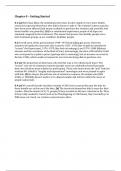Chapter 0 – Getting Started
0.1 (a) More than likely, the individuals who chose to take vitamin E were more health-
conscious in general than those who didn’t choose to take it. The vitamin E takers may also
have been more affluent (had money available to purchase the vitamins and, possibly, had
better health care generally). (b) In a randomized experiment, people of all types are
randomly assigned to the treatments. This means that poorer, less healthy people are in
both treatment groups, as are wealthier, healthier people.
0.2 Overall, most of this period (about 1940−1974) had falling gas prices. However,
instances of rapid price increases also occurred: 1931−1932 (due to policies intended to
“correct” the Depression), 1974−1975 (the Arab oil embargo), and 1979−1980 (Mideast
tensions and the overthrow of the Shah of Iran). Interestingly, the start of World War II did
not correspond to a spike in prices (perhaps due to rationing), but an increase occurred in
the late 1940s, which could correspond to war veterans being able to purchase cars.
0.3 (a) The proportion of Americans who feel this way is very likely much lower. The
“survey” was one of voluntary response (people were not randomly selected but made
their own decision about whether to participate). Those who knew about the “poll” had just
watched Mr. Schultz’s “lengthy and impassioned” monologue and were primed to agree
with him. (b) As long as the poll was one of voluntary response, the sample size (868;
2,500; or 100,000) doesn’t matter; it is a biased sample and will not reflect the views of
people nationwide.
0.4 (a) We can tell that the last three months of 2001 were unusual because the dots for
these months are at the top of the bars. (b) The terrorists themselves didn’t cause the fatal
crashes. After the attacks of 9/11, people (if they traveled at all) were reluctant to fly. Thus,
if they really needed to travel (such as for Thanksgiving or Christmas), they traveled by car.
With more car travel, car crashes occurred more often.
,Chapter 1 – Picturing Distributions with Graphs
1.1 (a) The individuals are the car makes and models. (b) For each individual, the
variables recorded are: vehicle class (categorical), transmission type (categorical),
number of cylinders (usually treated as quantitative), city mpg (quantitative),
highway mpg (quantitative), and annual fuel cost in dollars (quantitative).
1.2 Answers will vary. Some possible categorical variables: whether or not the
student plays sports; sex; whether or not the student smokes; and attitude about
exercise. Some possible quantitative variables: weight (kilograms or pounds), height
(centimeters or inches); resting heart rate (beats per minute); and body mass index
(kg/m2 or lb/ft2).
1.3 (a) 91% use these top social media sites; 9% use other sites most often. (b) A
bar graph is provided.
Percent Used Most Often Among Americans Aged 12—24
50
40
Percentage
30
20
10
0
Facebook Instagram Snapchat Twitter Google+ Pinterest Other
Social media site
(c) If you include an “Other” category, then a pie chart is appropriate. This survey
asked about the site used most often, so each individual is only represented in one
category, and the categories make up the whole.
,1.4 (a) Individuals fall into more than one of the categories. (b) A bar graph is
shown.
, 1.5 A pie chart can be made because the days are non-overlapping and make up the
whole. Some births are scheduled (induced labor, for example) and, probably, most
are scheduled for weekdays.
1.6 Make this histogram by hand, as the instructions suggest.
1.7 Use the applet to answer these questions.
1.8 The distribution is slightly right-skewed. The center is between 30% and 40%
(23 states have less than 30% minority residents, and another 10 states have
between 30% and 40%). The statewide percents range from about 0% to about
80%. No states have an unusually large or small percent of minority residents.
1.9 (a) There are two clear peaks in the distribution. If we gave only one center, it
would most likely be between these and not be truly representative. (b) Young boys
might spend a lot of time outdoors playing; their time outside in places where they
would encounter ticks might well be less in younger adulthood. With families and
yard work, their time outside might increase. (c) No, this is incorrect. Hiking in the
woods at any age will make a person more likely to encounter the ticks that spread
Lyme disease. (d) The histograms have the same shapes, but females have a slightly
lower incidence rate until age 65, after which females have a slightly higher rate.
Females under age 65, possibly, spend less time outdoors in areas where they would
encounter ticks.




